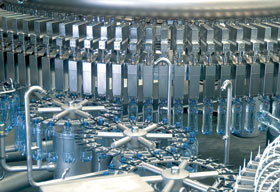

Electromagnetic flowmeters (magmeters) are popular and proven devices for flow measurement of electrically conductive process fluids and for volumetric filling machine applications. Unlike in most processes, magmeters in filling machine applications are frequently subject to widely varying conditions during normal operation, of prime importance to a meter’s accuracy is the condition of the metering section of the flow sensor.
PTB undertook a significant research project, in association with Krohne, to study the long-term measurement stability of magmeters in filling machine applications.
Principles of operation
Faraday’s law is the basis of a magmeter’s measuring principle and the design generally features an electrical isolating liner on the inner wall of the measuring tube. Linings such as PTFE, PFA or polypropylene or for hygienic reasons, PFA (perfluoroalkoxy) are used. PFA is known to absorb moisture under certain conditions, which means that it changes structure and shape which, in turn, affects the interior diameter of the measuring tube.
Changes in the inner diameter of the measuring tube lead to measurement errors, which can lead to problems, especially when extreme precision or repeatability are required. This only takes effect after the devices have been in use for longer periods of time and through the corresponding frequent cleaning processes using liquid or steam as are common in the food industry.
The effect is particularly significant when it comes to magmeters used on filling machines for filling PET bottles. In this case, an extremely high degree of repeatability is required and the quality of the filling process is directly visible in each individual bottle. That is why, in a joint research cooperative with the Physikalisch-Technischen Bundesanstalt (PTB), Krohne tested the measurement stability of filling magmeters. Filling magmeters with PFA liners and filling magmeters with ceramic measuring tubes were both tested. The PTB was interested in this test because for more than 20 years ceramic measuring tubes have been the norm in PTB measuring systems as well as in many other test stations.
Thanks to this test, the PTB was able to gain additional knowledge about the behaviour of these devices under difficult conditions.
Demands on magmeters on filling machines
Demands placed on the Magmeters on filling machines are among the highest in the entire process industry. The manufacturer expects the filling volume to remain exactly the same, in other words stable measuring accuracy of the magmeter over the entire life cycle of the machine, regardless of whether it is filling simple products like water or lemonade or difficult products such as hot juice with solid content. The quality of the filling is constantly controlled and sometimes documented. Underfilling is illegal and overfilling is bad for the company’s balance sheet.
This is made more difficult by the fact that these systems must comply with high hygienic standards and thus must often be subjected to hot water or steam cleaning. The extremely frequent (e.g. daily) steam cleanings at 135°C are particularly hard on the liner material.
On the one hand, PFA is known to be able to flow under the influence of pressure and temperature. This can be counteracted by inserting a stainless steel grate into the plastic, guaranteeing form stability and elasticity. In addition, water (steam) diffuses through the PFA liner and can condense behind the liner. When heated, this moisture can turn back into steam, distorting the liner.
The flow of the PFA and the steam diffusion can thus change the geometry of the measuring tube, and as a result, it no longer corresponds to the geometry at the time of the factory calibration. For example, a diameter change of 30 μm in DN 15 leads to measurement deviations of 0,2 to 0,4%. This illustrates that even small changes can have a tangible influence on filling accuracy. Usually, filling machines are only calibrated once, followed by many years of use without the need for recalibration. The prerequisite for this is the stability of the filling magmeter and its measuring tube geometry.
Conclusions
In the field of application of filling magmeters there are different measuring tube constructions: there is the stainless steel measuring tube with the PFA liner and the pressure-bearing monolithic ceramic measuring tube.
The testing of the magmeter nominal size 15, used very frequently in filling technology, at the PTB was done to clarify to what extent these tube constructions differ from one another in quality in terms of measurement stability. It was especially important to test the behaviour after a certain period of use and following thermal load due to CIP and SIP operations. The PTB measurement results conclude that filling magmeters with ceramic measuring tubes compared to magmeters with PFA lining:
* Have a temperature coefficient three times lower than change in the medium temperature.
* The long-term stability in the isolated view is at least three times better, on average eight times better.
* Repeatability depending on flow speed is 2 to 3 times better.
This has made it clear that when it comes to the long-term behaviour of filling magmeters, there are qualitative differences between measuring tubes with plastic lining and ceramic measuring tubes. The ceramic measuring tube remains mechanically stable despite the stress of heat and steam, which results in constantly higher repeatability of the filling quality.
For more information contact John Alexander, Krohne SA, +27 (0)11 314 1391, [email protected], www.krohne.com
| Tel: | +27 11 314 1391 |
| Email: | [email protected] |
| www: | www.za.krohne.com |
| Articles: | More information and articles about KROHNE |

© Technews Publishing (Pty) Ltd | All Rights Reserved